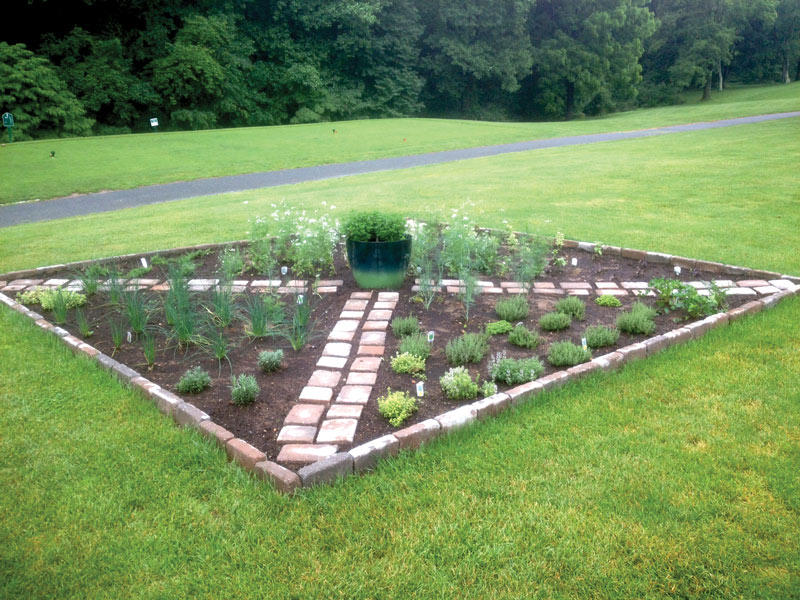
Plot of plenty: Located near the first tee box, the 8-by-8-foot herb and vegetable garden at Deerfield in Newark, Del., supplies ingredients that appear in a variety of offerings from the clubhouse menu, such as thyme for butternut squash soup, chives for mashed potatoes, beets for salads, and mint for mojitos. Photo courtesy of John Jacob
Those who visit Deerfield — an event venue, restaurant and golf course in Newark, Del. — to celebrate a wedding or simply enjoy a meal still get a taste of golf course superintendent John Jacob’s handiwork.
Since 2014, Jacob has extended his agronomic acumen into the realm of edibles, overseeing upkeep of an herb and vegetable garden situated between Deerfield’s clubhouse and the first tee box of the 18-hole public course. “Maintaining things on the grounds falls on my lap, no matter what,” says Jacob, a 17-year GCSAA member. “Superintendents know how to grow grass, so we can grow a lot of different things. It’s all farming — it’s just a different crop.”
Jacob was looped into the project because of his evident green thumb, but the garden was actually the brainchild of a member of Deerfield’s marketing staff who was looking to tap into the trend toward fresh, locally grown food to appeal to potential customers interested in holding an event at Deerfield.
The site for the garden was chosen for its sufficient sunlight, good air movement and well-drained soil, and also for its visibility from the clubhouse patio and the first tee box, to make it a point of engagement among guests, including golfers waiting to start their round. Jacob and his team carved out an 8-by-8-foot space — formerly tall fescue — using a sod cutter and did a soil test to ensure the native topsoil was indeed conducive to growing crops. Surplus brick pavers on hand from adding borders to the course’s ball washers and trash receptacles furnished the edging, and the area was ready to grow.
“I was worried at first that it was going to be a big labor investment, but it hasn’t. It’s much simpler than I imagined,” says Jacob of the garden, adding that the crew just tacks on the gardening tasks, such as hand watering and weeding, when they perform those duties around the clubhouse.
That’s not to say that switching from maintaining an expansive landscape for looks and playability to cultivating a petite plot of plants for human consumption didn’t entail a bit of a learning curve for Jacob and his team. For instance, the herbs and veggies prefer their soil drier than the annual flowers the crew was accustomed to caring for. The garden doesn’t receive any commercial fertilizer or other inputs, and the crew must be mindful to avoid the space when applying turf chemicals. Jacob was also concerned about the emergence of new pests and keeping resident raiders such as deer from nibbling on the spread. So far, though, the garden hasn’t been targeted by any animal or insect invaders.
When it comes to deciding what to grow, Jacob collaborates with Jerome Grochocki, Deerfield’s catering chef, who is an avid gardener. They pick crops based on what the kitchen will use and what will do well in the square footage. While the spot may be small, returns can be bountiful. In the garden’s first year, “We had enough chives to feed the whole state of Delaware,” Jacob says.
Jacob and Grochocki have since made adjustments and refinements, and the 2016 garden featured basil, chives, dill, mint, oregano, rosemary, sage, thyme, beets and okra, with strawberries and even a small fig tree joining the lineup next year. The grounds crew plants the garden in mid-May, and it’s productive from late spring until Thanksgiving. Yields vary by crop, and Grochocki — whose favorite garden-infused culinary creations include rosemary garlic butter and chicken Parmesan with oregano and basil — estimates quantities range from about half a pound of dill to about 6 pounds of oregano.
Deerfield does, of course, have to supplement its homegrown fare with ingredients from a food supplier to meet all of its dining demands. The value of the garden lies in more than just the heft of its harvests, however. “It’s a good tool to bring employees together from the course and the club who otherwise would never work together,” says Jacob, who has been at Deerfield since 2000. “Before, there was no reason I would interact with a chef, but now Jerome and I run into each other and work together on the garden.” Jacob says such a project is also a way for superintendents to demonstrate the versatility of their skill set and knack for tackling new initiatives.
Jacob’s advice to superintendent gardeners? Welcome advice and assistance. The Deerfield garden’s layout, for example — an “X” that’s traversable, with the prolific producer mint contained to a pot in the center — came courtesy of a master gardener to whom Jacob was introduced through the University of Delaware Cooperative Extension while working on the course’s Audubon Cooperative Sanctuary recertification. “When I reached out to the master gardener and others, everyone was more than helpful and very enthusiastic about being involved,” Jacob says.
For Grochocki, success is all about wise site selection — focus on soil quality and drainage, he advises — and an open mind. “Most things will grow pretty much anywhere with a little bit of love,” Grochocki says. “And there’s always something you can do with fresh herbs.”
Megan Hirt is GCM’s managing editor.